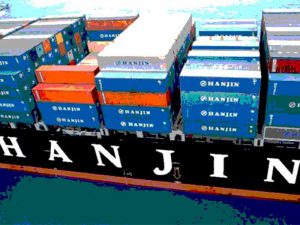
Court declares Hanjin Shipping bankrupt
FEBRUARY 17, 2017 — South Korea’s Yonhap news agency reports that Hanjin Shipping Co. was today officially declared bankrupt by the Seoul Central District Court, after a two-week period for appeal expired.

FEBRUARY 17, 2017 — South Korea’s Yonhap news agency reports that Hanjin Shipping Co. was today officially declared bankrupt by the Seoul Central District Court, after a two-week period for appeal expired.
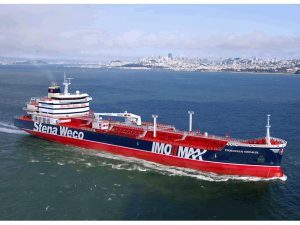
As we pointed out in our Annual Yearbook & Maritime Review back in June, shipyards are struggling amid the downturn in the market, with newbuilding orders at their lowest levels since the 1980s. As further evidence, during the first half of 2016, orders for new ships worldwide dropped 65 percent as compared with the first half of last year, according to VesselsValue.
The leading ship valuation provider says that 689 newbuilds were ordered in the first half of 2015 as compared with a mere 239 this year.
As we mark the midway part of this year, VesselsValue also points out that $28.4 billion worth of vessels have been delivered this year, with another $43.8 billion worth still on the orderbooks and due for delivery in 2016. VesselsValue says that there a total of 2,518 vessels to be built in 2016, with 1,613 as yet undelivered by mid-year. Almost a third of the undelivered vessels are bulkers.
LPG tanker deliveries are on track for the year, with 50% of the 2016 orderbook having been delivered (worth $3.0 billion). However there is still 80% of the Offshore Support Vessel (OSV) orderbook still undelivered, valued at $5.5 billion. Overall, only 93 of the 500 OSVs on order were delivered to the fleet this year. VesselsValue Valuation Analysts say many of the undelivered vessels in underperforming markets are candidates for slippage: the vessel’s delivery date may be pushed back into the next few years.
The tanker outlook
Updating its Mid-Year Tanker Market Outlook, McQuilling Services says that 49 uncoated tankers were delivered at the end of July, representing “36% of our full-year expectations and supporting our original thoughts of a second half skew of tanker deliveries.” McQuilling Services sees the supply outlook over the next five years as a “tale of two halves.” It says the present year along with 2017 are projected to increase the DPP fleet as a whole by 3.6% and 5.7% on an average inventory basis. In total, we project 62 coated Aframaxes (LR2) and 46 coated Panamaxes (LR1) to join the fleet over 2016 and 2017, of which 27 have delivered as of August.
McQuilling Services says, “We anticipate that LR2 inventory will expand 10.7% and 9.9% in 2016 and 2017, respectively amid high deliveries and minimal deletions, while the MR product segment is to average only 1.0% growth through 2020. Overall, Clean Petroleum Products (CPP) growth will average 3.5% in 2016 before trending lower over the forecast period. The net fleet growth of the chemical fleet (IMO 2) is projected to expand by 13.5% in 2016, reducing to 3.4% in 2018 and below 2.0% in 2019 and 2020.
“We project spot rates for Dirty Petroleum Products (DPP) voyages to exhibit weakness in 2017 amid accelerating supply growth. TD3 freight rates will average WS 57 in 2017 before increasing to WS 71 by 2020. Floating storage economics may help stabilize the recent downturn in the market. Correspondingly, we anticipate VLCC TCE levels to average $33,800/day in 2017. Suezmax rates on TD20 are projected to average WS 66 in 2017, returning owners $15,300/day during the year. Aframax rates are likely to be elevated in the East with TD8 returning owners $19,600/day in 2017, following $22,300/day in 2016.”
According to McQuilling, CPP rates are likely to remain stable in 2017 due to increasing demand and decelerating supply. TC1 rates will average WS 108 in 2017, returning owners $19,200/day, while the LR1 trading the same voyage will generate earnings of $13,800/day. Gradually increasing freight rates through 2020 are projected. For MR owners, it is projected that vessels positioned in Asia will earn more than those in the West amid expanding refinery capacity in the East and slowing demand in the West. The TC2/TC14 triangulation will return owners $11,806/day in 2017.
Asset prices for secondhand DPP tankers will see losses continue into 2017 amid a weakening rate environment, while CPP values may see a slight uptick amid a more stable earnings outlook. Declining shipyard capacity and higher commodity prices may lead to a slight increase in newbuilding values next year.
Cruise market booming
The cruise ship market is booming, with orders for more than 60 cruise vessels valued at over $44 billion, including two 100-passenger coastal cruise ships being built at Nichols Brothers Boat Builders, Whidbey Island, WA, and two overnight cruise ships at Chesapeake Shipbuilding in Salisbury, MD. Chesapeake delivered the 185-passenger America to its sister company American Cruise Line in the first quarter of this year.
Matson orders two CONROs
In the U.S., orders for the first half of 2016 for new oceangoing ships for Jones Act trade have slowed, with shipyards working off their existing backlogs. The second half of the year started off with a bang as Matson Navigation awarded a $511 million contract to General Dynamics NASSCO, San Diego, CA, last month for two new LNG-Ready Container Roll-on/Roll-Off (CONRO) vessels that will have a capacity of 3,500 TEU. The two CONROs would be the 30th and 31st LNG-powered or LNG-Ready ships built, in operation, under construction or conversion for Jones Act service.
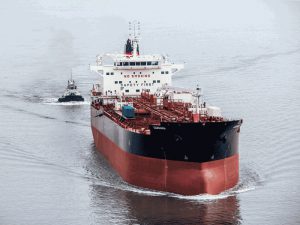
The total capacity of these vessels is just over 7 million deadweight tons (dwt), with a total current value of $4.5 billion (See Table 1: Value of U.S.-Built Shipping). Globally, the United States (as a shipbuilding nation) is ranked in 11th place (in terms of dwt) and a respectable sixth place behind South Korea, Japan, China, the Philippines, Germany, and Turkey in terms of the current value of the U.S. built fleet. Based on the volume of ships on the water, the most prolific U.S. shipbuilder has been NASSCO, San Diego, CA, a unit of General Dynamics. NASSCO also operates shipyards on the U.S. East Coast in Mayport, FL, and Norfolk, VA. As of mid-March, VesselsValue estimated the ships being built at NASSCO had values of around $900 million (this value excludes delivered ships). NASSCO recently launched the 53,700 dwt MR tanker Independence, which VesselsValue currently values at $133.45 million (this excludes a premium for the Jones Act). The Independence will be joined by two MR2 tankers on order at NASSCO for Seabulk Tankers. As of mid-March, NASSCO had four MR2 tankers on its order book for American Petroleum Tankers. 
The San Diego shipyard delivered two LNG-fuelled 3,100-TEU containerships, including the lead of the Marlin class, the Isla Bella, in November 2015 to Tote Maritime. The Isla Bella, along with its sister, Perla dela Caribe, are now operating between Jacksonville, FL, and San Juan, PR.
The only other U.S. shipyard with bulker, tanker, and gas carrier vessels currently on its order book is Philly Shipyard, Philadelphia, PA (formerly known as Aker Philadelphia Shipyard Inc.) Philly Shipyard has built product tankers, crude carriers, and containerships. The Philly Shipyard built fleet is currently valued at just over $1 billion. Its order book consists of eight 50,000 dwt MR tankers and this design has been classed by ABS as LNG Ready, which provides the owner with the flexibility to choose to convert the ship to dual fuel operation in the future.
In early May, Crowley Maritime Corporation christened the Louisiana, third of four LNG Ready product tankers at the Julia Street Cruise Terminal in New Orleans, LA.
Like its sisters, the 600 ft Louisiana is based on a proven design from Korea’s Hyundai Mipo Dockyards (HMD) design. It can carry crude oil or refined petroleum products, as well as other chemical products.
Construction management services were provided by Crowley’s marine solutions group, which provides oversight and management in shipyards across the country for Crowley and other third-party companies. Philly Shipyard also built the tankers Texas and Ohio for Crowley, and the fourth ship in the program is under construction with delivery planned for third quarter 2016.
“The christening underscores our continued commitment to building and operating innovative vessels that deliver the best possible service and efficiency for our customers who depend on us for safe and reliable transportation of petroleum products,” says Rob Grune, Senior Vice President and General Manager, Petroleum Services. “And, as is the case with its sister ships, we designed and built the Louisiana to have the capability to be converted to LNG propulsion in the future, increasing the likelihood of a long service life as new emissions regulations are developed in the years ahead.”
JONES ACT FLEET CONSIDERABLY OLDER THAN WORLD FLEET
It’s no secret that the U.S. Jones Act fleet is considerably older than the average age of the global, non-U.S.-built fleet. The current U.S.-built fleet has an average age of 33 years old versus 13 years old for the global fleet. The most recent ships produced by U.S. shipyards have been tankers and the average age of U.S.-built tankers is only five years older than the global fleet. However, there has been virtually no U.S. investment in bulkers (many of them are part of the Great Lakes fleet). The U.S.-built bulker fleet has an average age of 46 years old versus nine years old for the global fleet. Even a relatively modern ship type, such as containerships, the average age of the U.S.-built fleet is 32 years old, considerably older than the average of 11 years old for non-U.S.-built vessels.
TOP TEN U.S. SHIPOWNERS
According to VesselsValue, the Top Ten U.S. shipowners ranked by value control around half the capacity (48%) of the U.S. fleet (see Table 2. U.S. Shipowners Ranked by Fleet Value).
The Top Ten Shipowners are tanker companies or the tanker arms of oil majors. The current most valuable U.S.-operated fleet is that American Shipping Co., a Norwegian public company controlling a fleet of 10 MR2 tankers built by Philly Shipyard and leased out to OSG, which charters them out to Jones Act qualifying companies. VesselsValue estimates this fleet is worth $830 million. The second most valuable U.S. fleet belongs to new entrant American Petroleum Tankers, which is a subsidiary of Kinder Morgan Terminals, with its fleet operated by Crowley Maritime Corporation, Jacksonville, FL. This fleet will be supplemented by MR tankers currently on the order book of NASSCO. However, in the last 12 months, the U.S. order book has been very quiet, with no bulker, tankers or gas carriers ordered.
SALE AND PURCHASE ACTIVITY
If there is one area where U.S. shipping has been active, it’s been in the sale and purchase market. The dire dry bulk market is one of the driving forces behind Scorpio Bulker selling 25 vessels in the last 12 months (March 2015 to March 2016) for a combined value (at the time of sale) of $878 million (where the sale price is undisclosed, the VV Value the day of the sale is used). Altogether 88 vessels have been sold by U.S. owners for a combined value (where the sale price is undisclosed, the VV Value the day of the sale is used) of $3.4 billion (see Table 3: Sales by U.S. Owners).
Of course, under the Jones Act, U.S. companies cannot purchase foreign-built vessels to operate in Jones Act trade routes. This reduces the pool of potential purchases, which in the last 12 months (March 2015-March 2016) have been limited to eight vessels, including four MR tankers from Philly Shipyard purchased by Kinder Morgan for a reported $568 million (See Table 4: Purchases by U.S. Owners).
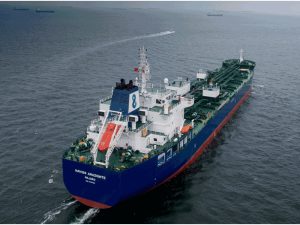
The birth of VesselsValue was driven by timing and need. In 2008, the crisis in the financial market extended into shipping. The dry bulk sector and the containership sector were hit the hardest, and while tankers remained relatively buoyant, banks needed to assess their capital commitments against the value of the assets being financed and being used as collateral. However, in the depth of the crisis (2010 / 2011), ship brokers were telling clients they could not value the ships as there had been no recent sale or “last done” in ship broker speak. Richard Rivlin, a sale and purchase broker with 30 years’ experience, had long felt that an automatic valuation system could be built, which would produce valuations in any market, at any time. Luckily, his brother is a Professor of Mathematics, and together they designed and built such a system. It quickly became apparent that the highly detailed multi-level regression model was far too complex for normal spreadsheets, and a specialist modelling company was employed to develop the model.
The model is fed by two databases. One contains the features and specification of the ships arranged in a unique structure that allows the computational model high speed access. This database is researched and compiled by VesselsValue own team of 30 researchers and analysts on the Isle of Wight in the UK. The second database consists of sale and purchase transactions and charters. Both feed the mathematic model which is operated by a team of quantitative analysts. The aim was to produce an instant, accurate and always available online ship valuations for the banks and finance houses, that form the main customers of VesselsValue.
Tankers Valuation
According to VesselsValue, five factors make up a valuation:
Each factor is broken down into further elements that are scored. As an asset, tankers are relatively straightforward, being highly commoditized, and standardized in terms of size ranges and specification. In part this is due to the international safety and pollution control legislation that has been forced on the tanker sector. This level of standardization makes VesselsValue task somewhat easier when it comes to scoring the factors, than offshore vessels, which have just been added to the system. In the case of tankers, there are around 140 scores. One of the most important scores is the shipyard. A vessel built in China is less desirable than one built in Japan. A well-published example is the one shown above. In November 2014, the New Century-built Supramax bulker ACS Diamond was sold for $10 million. The previous week, the slightly older Japanese-built pair of Supramaxes were sold for $15.5 million each. This was an implied discount of around 40% between Japan and China. However, the shipyard scoring goes into several levels of sophistication, including many ships the shipyard has built and when the last vessel was constructed.
This model is continually updated and recalibrated overnight to give the closest possible fit to the reported sales prices. It is the analysis of the sales that can produce the weightings required for different shipyards. These are applied to all shipyards, not just Chinese shipyards.
So far VesselsValue have performed over 1,000,000 valuations to date, about 400,000 a year and the number is increasing.
How Accurate is VesselsValue?
The split of VV customers are banks and finance houses, owners and other maritime industries such as lawyers, insurers and charterers – sophisticated market participants who insist on knowing the methodology behind our valuations. But ultimately they want to know how accurate are our valuations because this will affect their bottom line. Valuation accuracy is assessed as the difference between the price a vessel is sold at, and VV valuation on the day before the actual sales date. This is expressed as a % of valuations within a certain band of accuracy and shown in a chart form. The accuracy report is available on the website.
Tanker Valuations Development
According to the VesselsValue transactions database, between the start of 2012 and May 2016, a total value of $143 billion of tankers have been traded on the sale and purchase market. During that period the value of second-hand tankers has steadily increased, as can be seen from figure 1 (“VV Tanker Matrix”) below of the VV Tanker Matrix, expressed as USD / DWT.
During that period, the MR tanker has been the most frequently traded tanker type, both in terms of number of sales, and value (see figure 2 “Total Value by Type of Tankers Sold 2012 to Date”).
So far in 2016 (to 15 May 2016) 83 tankers with a total value of $1.4 billion, have been traded on the second-hand market, and again the MR tanker is the most popular (see figure 3 “Value of Tankers Sales Jan 2016 to YTD).
Interestingly, the average age of MR2 (Chemical / Product) tankers sold in the first five and half months of 2016 is only three years-old. Altogether 17 of these vessels were sold in this period, with eight tankers being sold by owners in the USA (these were not Jones Act vessels).
The majority of tankers and the largest value of tankers sold so far this year (2016) were constructed in South Korea, followed by Japan and China. As far as owners are concerned, the lead seller across all types of tankers was Chembulk Tankers, Scorpio Tankers and companies associated with the Navig8 group (see figure 4 “Top Ten Sellers of Tankers Ranked by Number of Vessels Sold”).
Recent Sales of Interest
The top three sellers have sold tankers for completely different reasons and strategy. In January 2016, Chembulk Tankers was sold by parent company Berlian Laju Tanker (BLT) to private equity investor Kohlberg Kravis Roberts (KKR). Chembulk Tankers is said to have a number of Contracts of Affreightments (CoAs) and the older tankers were surplus to requirement. This is part of the KKR growth strategy to rebuild the Chembulk Tankers fleet. KKR has also invested in a fund to invest in two Greek bank shipping portfolios.
The number two top seller, Scorpio Tankers, was a tactical, opportunistic sale. The purchaser, Bahri (formerly known as National Chemical Carriers of Saudi Arabia) is on something of a buying spree. Bahri has recently purchased two VLCCs from Tanker Investments in December 2015, for a reported $77.5 million. The five 2014-built MR2 tankers were sold en bloc for $167 million are trading in the UAE under Bahri CoAs.
The third most active seller, Navig8 Chemical Tankers, Inc., sold the four resales (the MR2 tankers are due for delivery in 2017) under a ten-year bareboat charter (with purchase option) for a reported $35 million each. This was an internal sale within the group, and part of a longer term strategy.
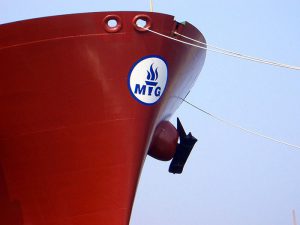
JUNE 15, 2016—Billionaire Greek shipping magnate John Angelicoussis was the biggest spender at the recently concluded Posidonia 2016 Exhibition in Athens. Angelicoussis, owner of Angelicoussis Shipping Group, which includes Anagel Maritime Services,
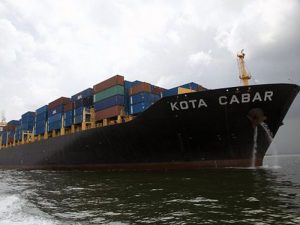
APRIL 20, 2016—Singapore owners control one of the largest fleets, in terms of value, writes Craig Jallal, Senior Data Editor at VesselsValue. This week is Singapore Maritime Week 2016, when the city-state
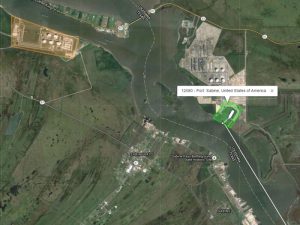
FEBRUARY 29, 2016—As we reported on February 25, the 160,000 m3 Asia Vision left Sabine Pass in Texas loaded with U.S.-produced LNG destined for Petrobras in Brazil. Craig Jallal, Senior Data Editor,
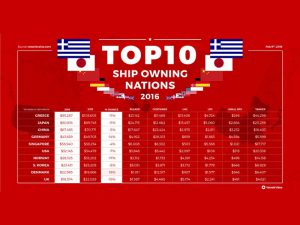
FEBRUARY 10, 2016—Greece is the top shipowning nation by fleet value in 2016, with a total fleet value of $95.29 billion, according to data compiled by VesselsValue.com. The valuation is based on
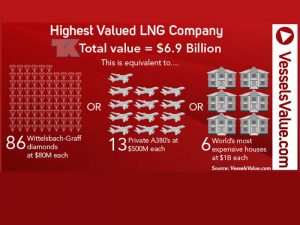
AUGUST 17, 2015—What company has the Highest Value Whole Gas (either LNG or LPG) shipping fleet? According to VesselsValue.com, that honor belongs to Teekay LNG Partners, with 37 vessels and a capacity
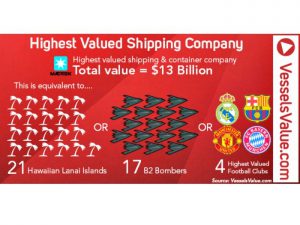
AUGUST 9, 2015—So who is the highest valued company in shipping? VesselsValue.com puts shipping and container giant A.P. Møller Maersk as the top dog with a valuation of about $13 billion, with